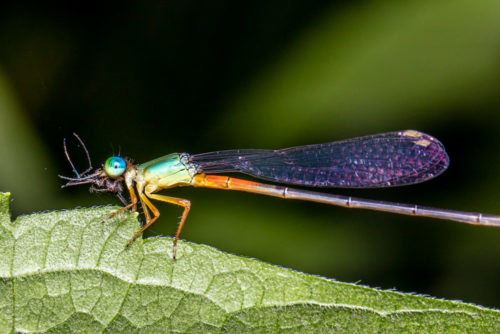
This female Orange-tailed Marsh Dart (Ceriagrion cerinorubellum) damselfly was on a leaf in my garden munching on a male Culex mosquito. Damselfly larvae are important aquatic predators. Besides serving as food for various fishes, the adults play a similar role on land. They do eat mosquitoes, and they also eat a vast variety of other insects thus helping to keep their population under control.

I used Canon EOS 5DS R with Canon EF 100mm f/2.8L Macro IS USM lens. This was illuminated by Godox Ving V860c E-TTL Li-ion Camera with LumiQuest SoftBox III to capture this beauty.

Mosquito larvae, for the most part, live right at the water’s surface. If they drop down to the bottom, damselfly larvae which prowl on underwater plants and the bottoms of ponds and lakes pounce and feed on them. Damselfly larvae, unfortunately, might also be the victim of other sorts of mosquito control practices which inadvertently target damselflies. In fact, Hawaiian damselfly species Megalagrion became seriously endangered when a primarily surface-feeding fish (Gambusia, the mosquito fish) was introduced for mosquito control and turned out to be a pretty good predator on damselfly larvae as well.

Damselflies are ideal indicators of wetland health because their larvae develop in water and include a full array of ecological types. This means that they can be used as indicators to monitor both positive and negative habitat changes. One of the world’s biggest problems today is related to its freshwater resources, both quality and quantity, and currently almost 40% of the world’s population experience serious water shortages. Dragonflies & Damselflies are already used to monitor wetland health in Europe, Japan, the USA and Australia, and it is hoped that soon monitoring and research of dragonflies and their habitats in other parts of the world, as well as encouraging their conservation.
Here is an interesting video of dragonfly larva hunting mosquito larvae.
[youtube]W557aSVdW_g[/youtube]
Orange-tailed Marsh Dart is a species of damselfly in the family Coenagrionidae. It’s commonly known as orange-tailed marsh dart or bi-coloured damsel. This is the quite a common and beautiful species of damselfly found particularly around ponds, drains, canal, open streams, etc. Orange-tailed Marsh Dart rests on dry twigs and vegetation over water. It is relatively big damselfly in size.

It attacks and feeds on other species of smaller damselflies. Its bluish-green head and orange base and the tip of the abdomen is quite distinctive and cannot be mistaken for other species. The female has a similar appearance, however, the red abdominal segments 7-10 is much duller. It is quite to approachable and getting a close-up shot is fairly easy.

This species can be found in Asia: Bangladesh, China, Indonesia, India, Sri Lanka, Myanmar, Malaysia, Philippines, Peninsular Malaysia, Singapore, Thailand, Vietnam. They are commonly found on the banks of ponds, rivers and canals sitting on dry twigs and vegetation over water. They breed in marshy banks of rivers, canals and ponds. The orange-tailed marsh dart is active from October to January.


Lovely Photos with Interesting Information Doc.